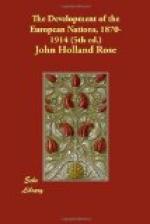Russia also has used to the full the advantages conferred by a central position, an inflexible policy, and a military-agrarian system well adapted to the needs of the nomadic peoples on her borders. In the fifteenth century, her polity emerged victorious from the long struggle with the Golden Horde of Tartars [I keep the usual spelling, though “Tatars” is the correct form]; and, as the barbarous Mongolians lost their hold on the districts of the middle Volga, the power of the Czars began its forward march, pressing back Asiatics on the East and Poles on the West. In 1556, Ivan the Terrible seized Astrakan at the mouth of the Volga, and victoriously held Russia’s natural frontiers on the East, the Ural Mountains, and the northern shore of the Caspian Sea. We shall deal in a later chapter with her conquest of Siberia, and need only note here that Muscovite pioneers reached the shores of the Northern Pacific as early as the year 1636.
Russia’s conquests at the expense of Turks, Circassians, and Persians is a subject alien to this narrative; and the tragic story of the overthrow of Poland at the hand of the three partitioning Powers, Russia, Prussia, and Austria, does not concern us here.
It is, however, needful to observe the means by which she was able to survive the dire perils of her early youth and to develop the colonising and conquering agencies of her maturer years. They may be summed up in the single word, “Cossacks.”
The Cossacks are often spoken of as though they were a race. They are not; they are bands or communities, partly military, partly nomadic or agricultural, as the case may be. They can be traced back to bands of outlaws who in the time of Russia’s weakness roamed about on the verge of her settlements, plundering indifferently their Slavonic kinsmen, or the Tartars and Turks farther south. They were the “men of the plain,” who had fled from the villages of the Slavs, or (in fewer cases) from the caravans of the Tartars, owing to private feuds, or from love of a freer and more lucrative life than that of the village or the encampment. In this debatable land their numbers increased until, Slavs though they mainly were, they became a menace to the growing power of the Czars. Ivan the Terrible sent expeditions against them, transplanted many of their number, and compelled those who remained in the space between the rivers Don and Ural to submit to his authority, and to give military service in time of war in return for rights of pasturage and tillage in the districts thenceforth recognised as their own. Some of them transferred their energies to Asia; and it was a Cossack outlaw, Jermak, who conquered a great part of Siberia. The Russian pioneers, who early penetrated into Siberia or Turkestan, found it possible at a later time to use these children of the plain as a kind of protective belt against the warlike natives. The same use was made of them in the South against Turks. Catharine II. broke the power of the “Zaporoghians” (Cossacks of the Dnieper), and settled large numbers of them on the River Kuban to fight the Circassians.




